Cross-Cultural Communication in Australian Business Report
VerifiedAdded on 2022/09/29
|10
|2190
|28
Report
AI Summary
This report delves into the complexities of cross-cultural business communication, specifically examining the challenges and strategies for an Australian agricultural supplier firm as it integrates Indian employees. The report emphasizes the importance of understanding cultural differences, referencing Hofstede's cultural analysis model to highlight disparities in power distance and communication styles between India and Australia. It provides practical recommendations for the country manager, including training on communication norms, such as being vocal and using various communication methods like CMC, and adapting to Australian business practices. The report also discusses competency and incompetency behaviors, offering guidelines for Indian employees to navigate the Australian business environment effectively, covering aspects like non-verbal cues, business etiquette, and written communication styles. The goal is to facilitate smooth integration and effective business operations across cultures.
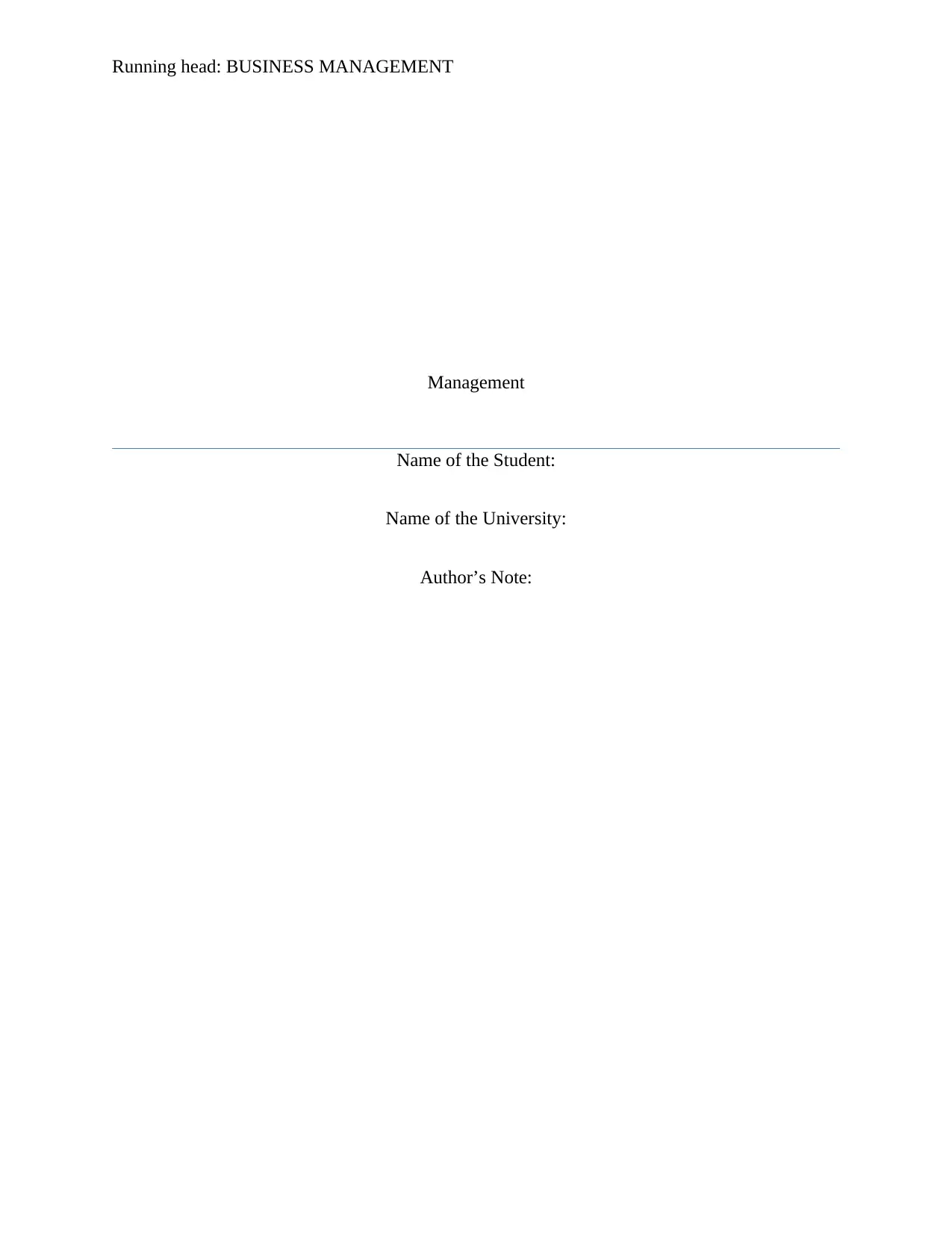
Running head: BUSINESS MANAGEMENT
Management
Name of the Student:
Name of the University:
Author’s Note:
Management
Name of the Student:
Name of the University:
Author’s Note:
Paraphrase This Document
Need a fresh take? Get an instant paraphrase of this document with our AI Paraphraser
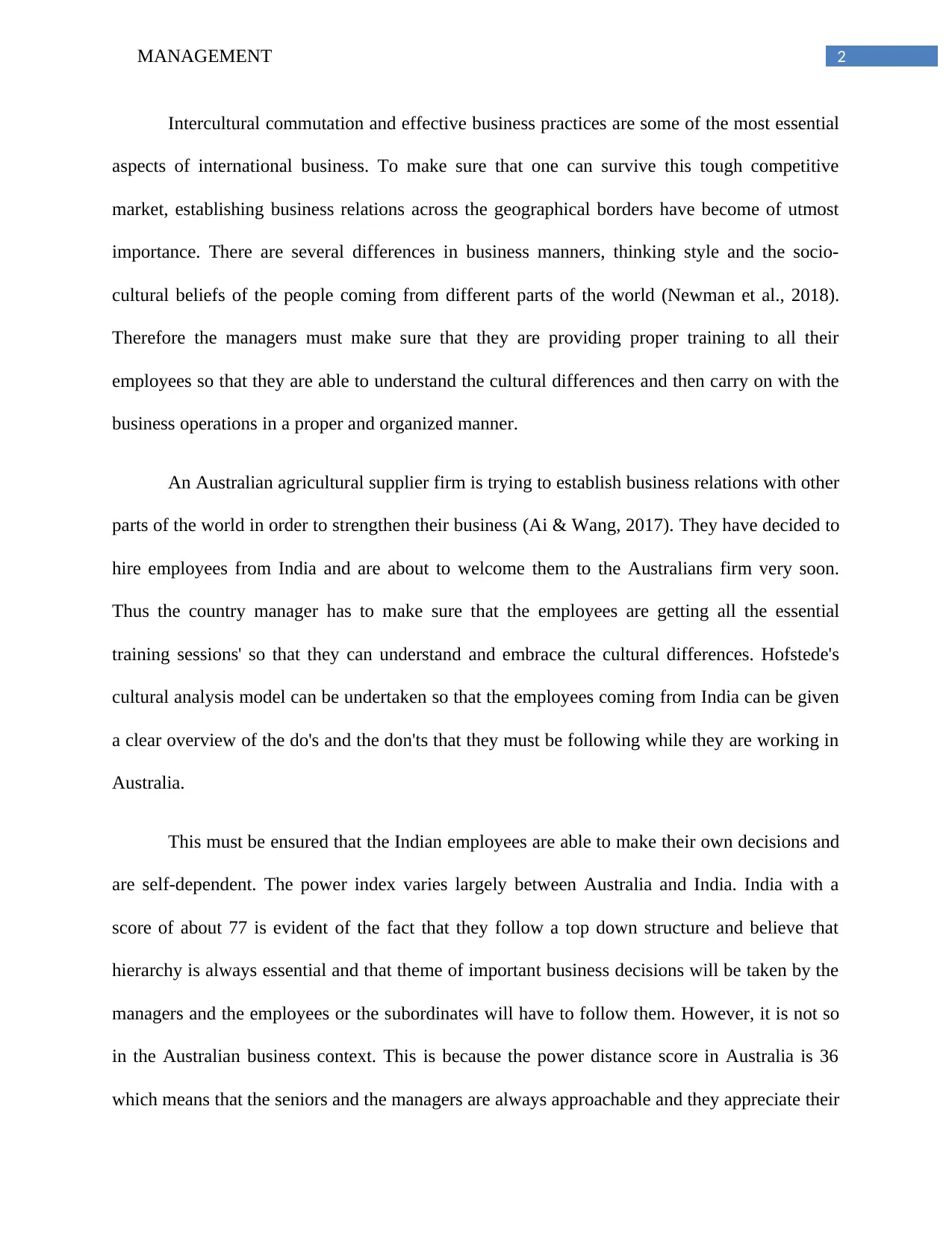
2MANAGEMENT
Intercultural commutation and effective business practices are some of the most essential
aspects of international business. To make sure that one can survive this tough competitive
market, establishing business relations across the geographical borders have become of utmost
importance. There are several differences in business manners, thinking style and the socio-
cultural beliefs of the people coming from different parts of the world (Newman et al., 2018).
Therefore the managers must make sure that they are providing proper training to all their
employees so that they are able to understand the cultural differences and then carry on with the
business operations in a proper and organized manner.
An Australian agricultural supplier firm is trying to establish business relations with other
parts of the world in order to strengthen their business (Ai & Wang, 2017). They have decided to
hire employees from India and are about to welcome them to the Australians firm very soon.
Thus the country manager has to make sure that the employees are getting all the essential
training sessions' so that they can understand and embrace the cultural differences. Hofstede's
cultural analysis model can be undertaken so that the employees coming from India can be given
a clear overview of the do's and the don'ts that they must be following while they are working in
Australia.
This must be ensured that the Indian employees are able to make their own decisions and
are self-dependent. The power index varies largely between Australia and India. India with a
score of about 77 is evident of the fact that they follow a top down structure and believe that
hierarchy is always essential and that theme of important business decisions will be taken by the
managers and the employees or the subordinates will have to follow them. However, it is not so
in the Australian business context. This is because the power distance score in Australia is 36
which means that the seniors and the managers are always approachable and they appreciate their
Intercultural commutation and effective business practices are some of the most essential
aspects of international business. To make sure that one can survive this tough competitive
market, establishing business relations across the geographical borders have become of utmost
importance. There are several differences in business manners, thinking style and the socio-
cultural beliefs of the people coming from different parts of the world (Newman et al., 2018).
Therefore the managers must make sure that they are providing proper training to all their
employees so that they are able to understand the cultural differences and then carry on with the
business operations in a proper and organized manner.
An Australian agricultural supplier firm is trying to establish business relations with other
parts of the world in order to strengthen their business (Ai & Wang, 2017). They have decided to
hire employees from India and are about to welcome them to the Australians firm very soon.
Thus the country manager has to make sure that the employees are getting all the essential
training sessions' so that they can understand and embrace the cultural differences. Hofstede's
cultural analysis model can be undertaken so that the employees coming from India can be given
a clear overview of the do's and the don'ts that they must be following while they are working in
Australia.
This must be ensured that the Indian employees are able to make their own decisions and
are self-dependent. The power index varies largely between Australia and India. India with a
score of about 77 is evident of the fact that they follow a top down structure and believe that
hierarchy is always essential and that theme of important business decisions will be taken by the
managers and the employees or the subordinates will have to follow them. However, it is not so
in the Australian business context. This is because the power distance score in Australia is 36
which means that the seniors and the managers are always approachable and they appreciate their
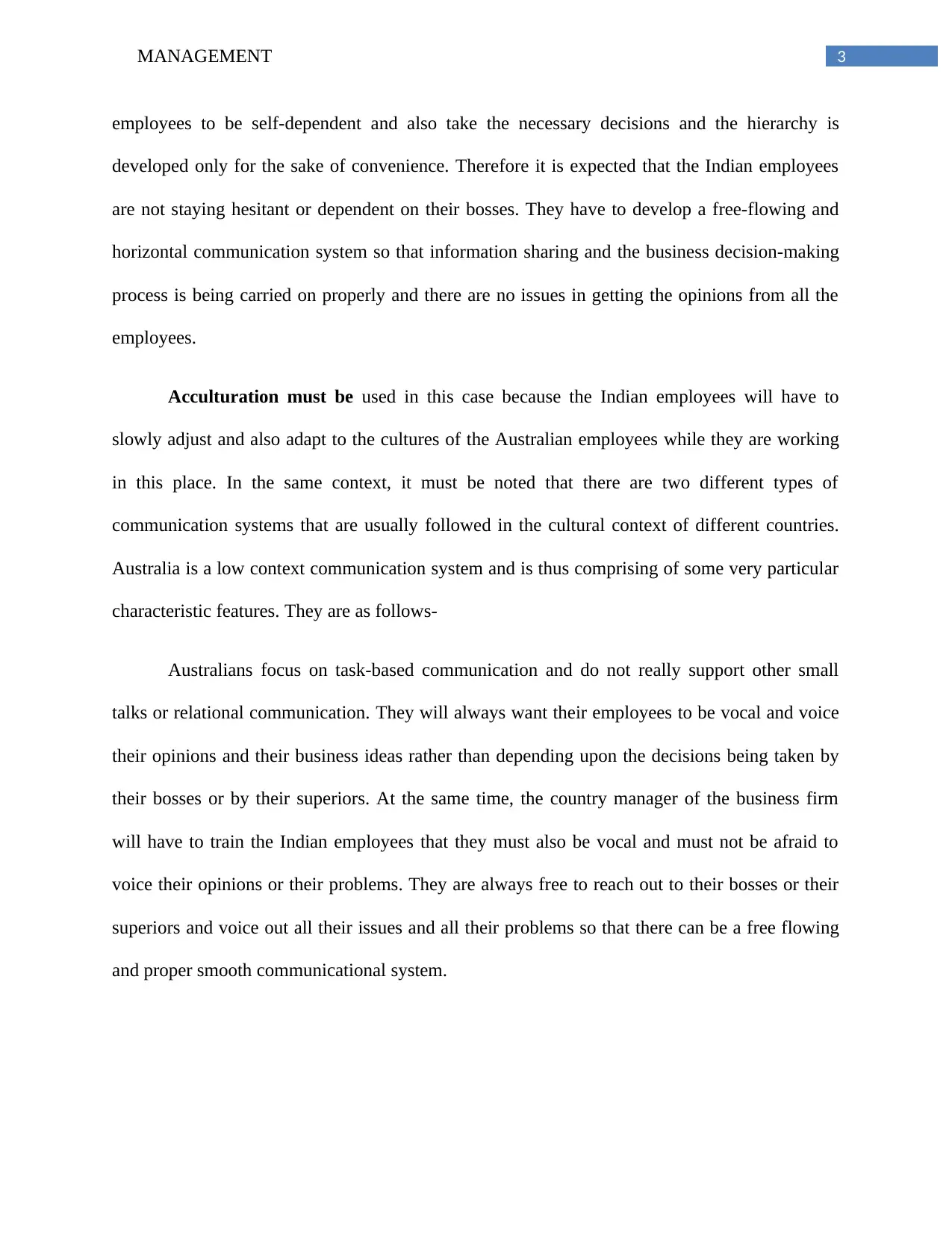
3MANAGEMENT
employees to be self-dependent and also take the necessary decisions and the hierarchy is
developed only for the sake of convenience. Therefore it is expected that the Indian employees
are not staying hesitant or dependent on their bosses. They have to develop a free-flowing and
horizontal communication system so that information sharing and the business decision-making
process is being carried on properly and there are no issues in getting the opinions from all the
employees.
Acculturation must be used in this case because the Indian employees will have to
slowly adjust and also adapt to the cultures of the Australian employees while they are working
in this place. In the same context, it must be noted that there are two different types of
communication systems that are usually followed in the cultural context of different countries.
Australia is a low context communication system and is thus comprising of some very particular
characteristic features. They are as follows-
Australians focus on task-based communication and do not really support other small
talks or relational communication. They will always want their employees to be vocal and voice
their opinions and their business ideas rather than depending upon the decisions being taken by
their bosses or by their superiors. At the same time, the country manager of the business firm
will have to train the Indian employees that they must also be vocal and must not be afraid to
voice their opinions or their problems. They are always free to reach out to their bosses or their
superiors and voice out all their issues and all their problems so that there can be a free flowing
and proper smooth communicational system.
employees to be self-dependent and also take the necessary decisions and the hierarchy is
developed only for the sake of convenience. Therefore it is expected that the Indian employees
are not staying hesitant or dependent on their bosses. They have to develop a free-flowing and
horizontal communication system so that information sharing and the business decision-making
process is being carried on properly and there are no issues in getting the opinions from all the
employees.
Acculturation must be used in this case because the Indian employees will have to
slowly adjust and also adapt to the cultures of the Australian employees while they are working
in this place. In the same context, it must be noted that there are two different types of
communication systems that are usually followed in the cultural context of different countries.
Australia is a low context communication system and is thus comprising of some very particular
characteristic features. They are as follows-
Australians focus on task-based communication and do not really support other small
talks or relational communication. They will always want their employees to be vocal and voice
their opinions and their business ideas rather than depending upon the decisions being taken by
their bosses or by their superiors. At the same time, the country manager of the business firm
will have to train the Indian employees that they must also be vocal and must not be afraid to
voice their opinions or their problems. They are always free to reach out to their bosses or their
superiors and voice out all their issues and all their problems so that there can be a free flowing
and proper smooth communicational system.
⊘ This is a preview!⊘
Do you want full access?
Subscribe today to unlock all pages.

Trusted by 1+ million students worldwide
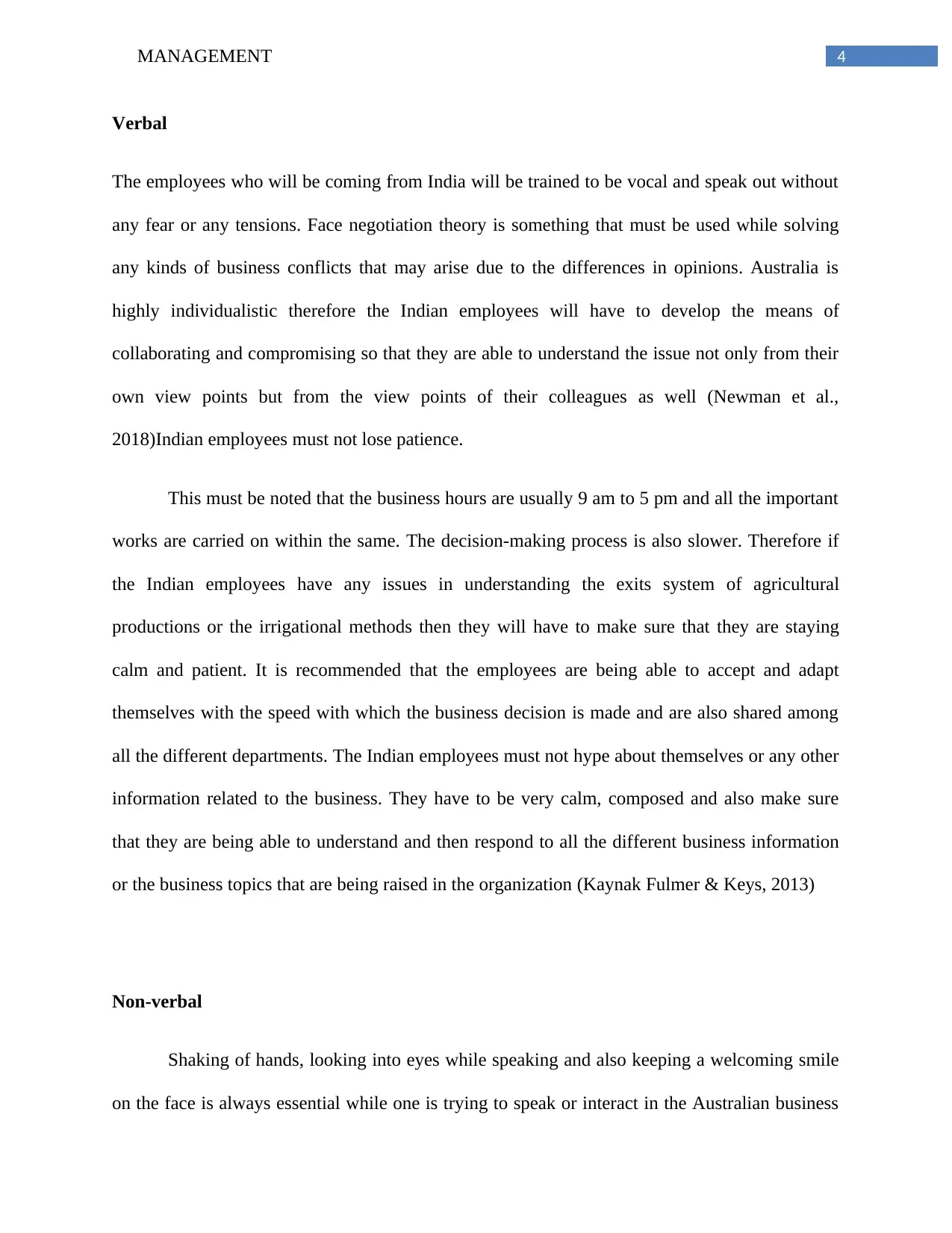
4MANAGEMENT
Verbal
The employees who will be coming from India will be trained to be vocal and speak out without
any fear or any tensions. Face negotiation theory is something that must be used while solving
any kinds of business conflicts that may arise due to the differences in opinions. Australia is
highly individualistic therefore the Indian employees will have to develop the means of
collaborating and compromising so that they are able to understand the issue not only from their
own view points but from the view points of their colleagues as well (Newman et al.,
2018)Indian employees must not lose patience.
This must be noted that the business hours are usually 9 am to 5 pm and all the important
works are carried on within the same. The decision-making process is also slower. Therefore if
the Indian employees have any issues in understanding the exits system of agricultural
productions or the irrigational methods then they will have to make sure that they are staying
calm and patient. It is recommended that the employees are being able to accept and adapt
themselves with the speed with which the business decision is made and are also shared among
all the different departments. The Indian employees must not hype about themselves or any other
information related to the business. They have to be very calm, composed and also make sure
that they are being able to understand and then respond to all the different business information
or the business topics that are being raised in the organization (Kaynak Fulmer & Keys, 2013)
Non-verbal
Shaking of hands, looking into eyes while speaking and also keeping a welcoming smile
on the face is always essential while one is trying to speak or interact in the Australian business
Verbal
The employees who will be coming from India will be trained to be vocal and speak out without
any fear or any tensions. Face negotiation theory is something that must be used while solving
any kinds of business conflicts that may arise due to the differences in opinions. Australia is
highly individualistic therefore the Indian employees will have to develop the means of
collaborating and compromising so that they are able to understand the issue not only from their
own view points but from the view points of their colleagues as well (Newman et al.,
2018)Indian employees must not lose patience.
This must be noted that the business hours are usually 9 am to 5 pm and all the important
works are carried on within the same. The decision-making process is also slower. Therefore if
the Indian employees have any issues in understanding the exits system of agricultural
productions or the irrigational methods then they will have to make sure that they are staying
calm and patient. It is recommended that the employees are being able to accept and adapt
themselves with the speed with which the business decision is made and are also shared among
all the different departments. The Indian employees must not hype about themselves or any other
information related to the business. They have to be very calm, composed and also make sure
that they are being able to understand and then respond to all the different business information
or the business topics that are being raised in the organization (Kaynak Fulmer & Keys, 2013)
Non-verbal
Shaking of hands, looking into eyes while speaking and also keeping a welcoming smile
on the face is always essential while one is trying to speak or interact in the Australian business
Paraphrase This Document
Need a fresh take? Get an instant paraphrase of this document with our AI Paraphraser
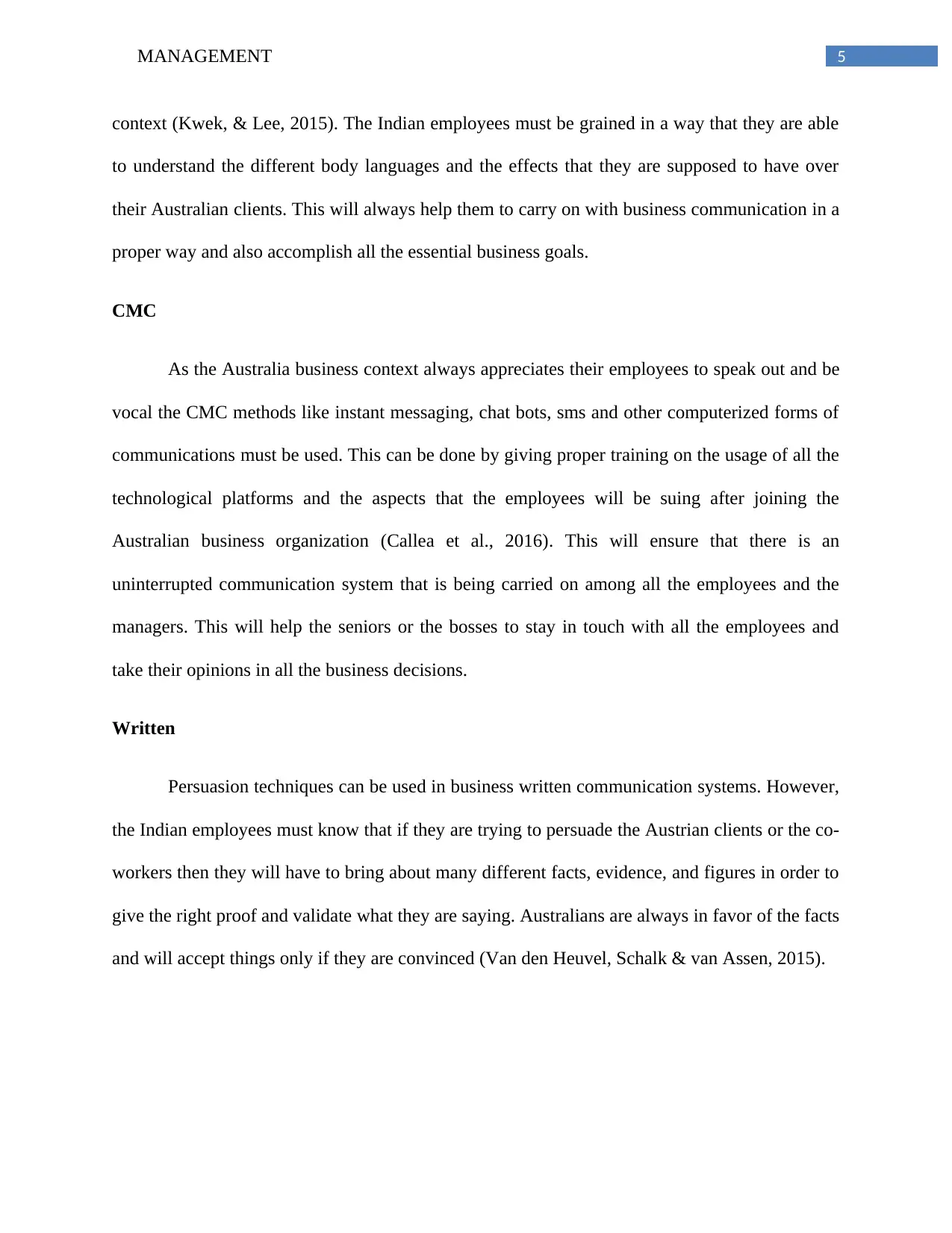
5MANAGEMENT
context (Kwek, & Lee, 2015). The Indian employees must be grained in a way that they are able
to understand the different body languages and the effects that they are supposed to have over
their Australian clients. This will always help them to carry on with business communication in a
proper way and also accomplish all the essential business goals.
CMC
As the Australia business context always appreciates their employees to speak out and be
vocal the CMC methods like instant messaging, chat bots, sms and other computerized forms of
communications must be used. This can be done by giving proper training on the usage of all the
technological platforms and the aspects that the employees will be suing after joining the
Australian business organization (Callea et al., 2016). This will ensure that there is an
uninterrupted communication system that is being carried on among all the employees and the
managers. This will help the seniors or the bosses to stay in touch with all the employees and
take their opinions in all the business decisions.
Written
Persuasion techniques can be used in business written communication systems. However,
the Indian employees must know that if they are trying to persuade the Austrian clients or the co-
workers then they will have to bring about many different facts, evidence, and figures in order to
give the right proof and validate what they are saying. Australians are always in favor of the facts
and will accept things only if they are convinced (Van den Heuvel, Schalk & van Assen, 2015).
context (Kwek, & Lee, 2015). The Indian employees must be grained in a way that they are able
to understand the different body languages and the effects that they are supposed to have over
their Australian clients. This will always help them to carry on with business communication in a
proper way and also accomplish all the essential business goals.
CMC
As the Australia business context always appreciates their employees to speak out and be
vocal the CMC methods like instant messaging, chat bots, sms and other computerized forms of
communications must be used. This can be done by giving proper training on the usage of all the
technological platforms and the aspects that the employees will be suing after joining the
Australian business organization (Callea et al., 2016). This will ensure that there is an
uninterrupted communication system that is being carried on among all the employees and the
managers. This will help the seniors or the bosses to stay in touch with all the employees and
take their opinions in all the business decisions.
Written
Persuasion techniques can be used in business written communication systems. However,
the Indian employees must know that if they are trying to persuade the Austrian clients or the co-
workers then they will have to bring about many different facts, evidence, and figures in order to
give the right proof and validate what they are saying. Australians are always in favor of the facts
and will accept things only if they are convinced (Van den Heuvel, Schalk & van Assen, 2015).
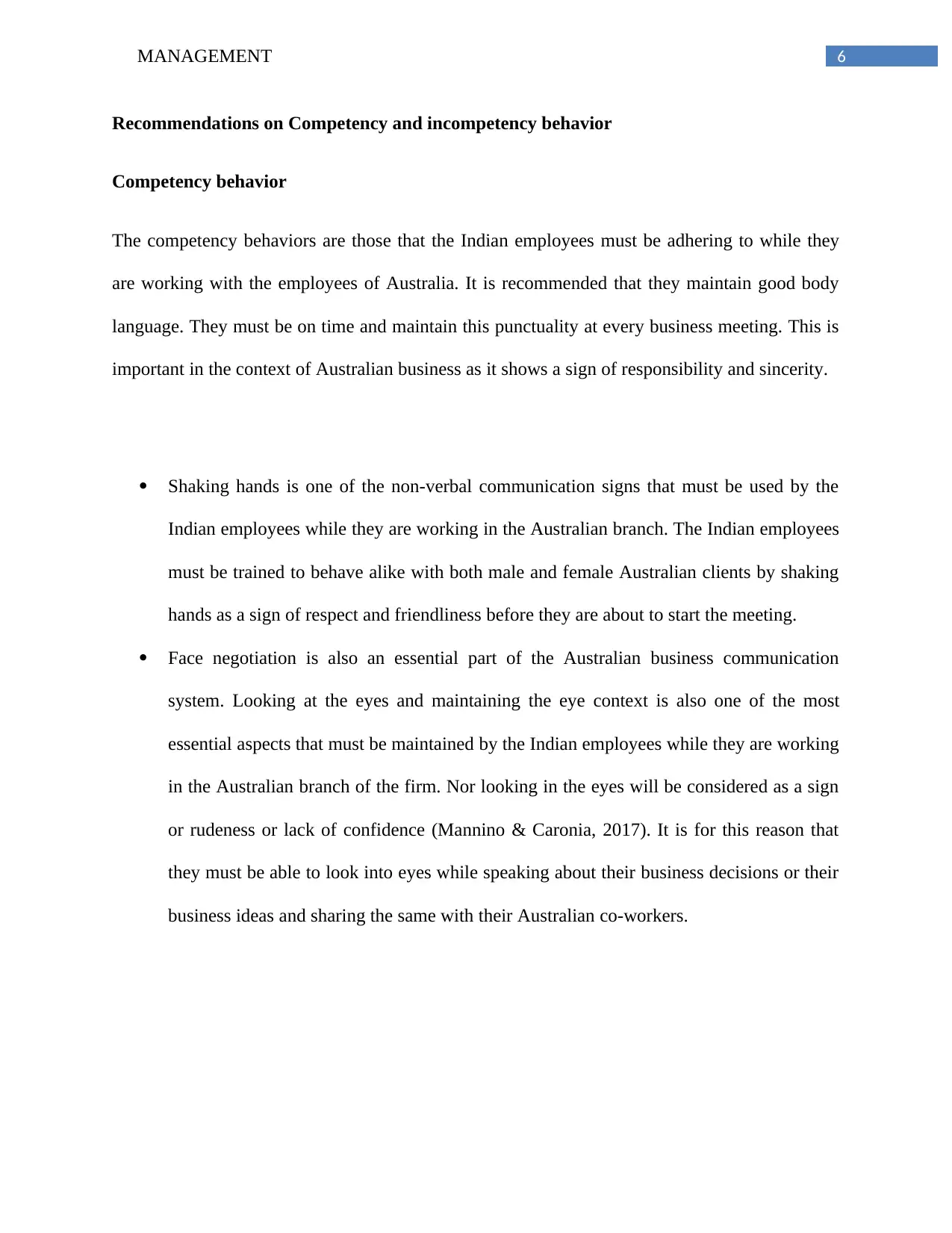
6MANAGEMENT
Recommendations on Competency and incompetency behavior
Competency behavior
The competency behaviors are those that the Indian employees must be adhering to while they
are working with the employees of Australia. It is recommended that they maintain good body
language. They must be on time and maintain this punctuality at every business meeting. This is
important in the context of Australian business as it shows a sign of responsibility and sincerity.
Shaking hands is one of the non-verbal communication signs that must be used by the
Indian employees while they are working in the Australian branch. The Indian employees
must be trained to behave alike with both male and female Australian clients by shaking
hands as a sign of respect and friendliness before they are about to start the meeting.
Face negotiation is also an essential part of the Australian business communication
system. Looking at the eyes and maintaining the eye context is also one of the most
essential aspects that must be maintained by the Indian employees while they are working
in the Australian branch of the firm. Nor looking in the eyes will be considered as a sign
or rudeness or lack of confidence (Mannino & Caronia, 2017). It is for this reason that
they must be able to look into eyes while speaking about their business decisions or their
business ideas and sharing the same with their Australian co-workers.
Recommendations on Competency and incompetency behavior
Competency behavior
The competency behaviors are those that the Indian employees must be adhering to while they
are working with the employees of Australia. It is recommended that they maintain good body
language. They must be on time and maintain this punctuality at every business meeting. This is
important in the context of Australian business as it shows a sign of responsibility and sincerity.
Shaking hands is one of the non-verbal communication signs that must be used by the
Indian employees while they are working in the Australian branch. The Indian employees
must be trained to behave alike with both male and female Australian clients by shaking
hands as a sign of respect and friendliness before they are about to start the meeting.
Face negotiation is also an essential part of the Australian business communication
system. Looking at the eyes and maintaining the eye context is also one of the most
essential aspects that must be maintained by the Indian employees while they are working
in the Australian branch of the firm. Nor looking in the eyes will be considered as a sign
or rudeness or lack of confidence (Mannino & Caronia, 2017). It is for this reason that
they must be able to look into eyes while speaking about their business decisions or their
business ideas and sharing the same with their Australian co-workers.
⊘ This is a preview!⊘
Do you want full access?
Subscribe today to unlock all pages.

Trusted by 1+ million students worldwide
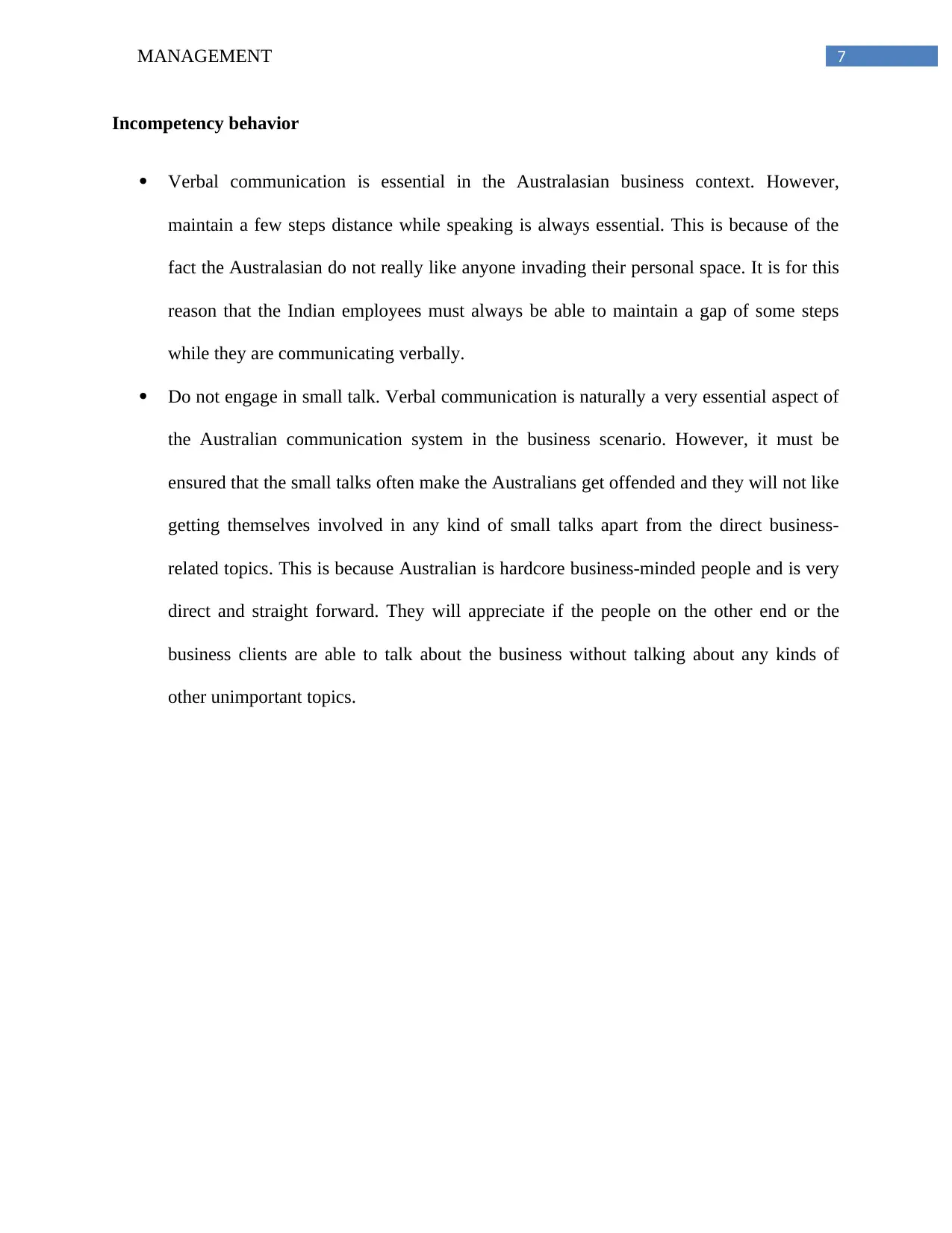
7MANAGEMENT
Incompetency behavior
Verbal communication is essential in the Australasian business context. However,
maintain a few steps distance while speaking is always essential. This is because of the
fact the Australasian do not really like anyone invading their personal space. It is for this
reason that the Indian employees must always be able to maintain a gap of some steps
while they are communicating verbally.
Do not engage in small talk. Verbal communication is naturally a very essential aspect of
the Australian communication system in the business scenario. However, it must be
ensured that the small talks often make the Australians get offended and they will not like
getting themselves involved in any kind of small talks apart from the direct business-
related topics. This is because Australian is hardcore business-minded people and is very
direct and straight forward. They will appreciate if the people on the other end or the
business clients are able to talk about the business without talking about any kinds of
other unimportant topics.
Incompetency behavior
Verbal communication is essential in the Australasian business context. However,
maintain a few steps distance while speaking is always essential. This is because of the
fact the Australasian do not really like anyone invading their personal space. It is for this
reason that the Indian employees must always be able to maintain a gap of some steps
while they are communicating verbally.
Do not engage in small talk. Verbal communication is naturally a very essential aspect of
the Australian communication system in the business scenario. However, it must be
ensured that the small talks often make the Australians get offended and they will not like
getting themselves involved in any kind of small talks apart from the direct business-
related topics. This is because Australian is hardcore business-minded people and is very
direct and straight forward. They will appreciate if the people on the other end or the
business clients are able to talk about the business without talking about any kinds of
other unimportant topics.
Paraphrase This Document
Need a fresh take? Get an instant paraphrase of this document with our AI Paraphraser
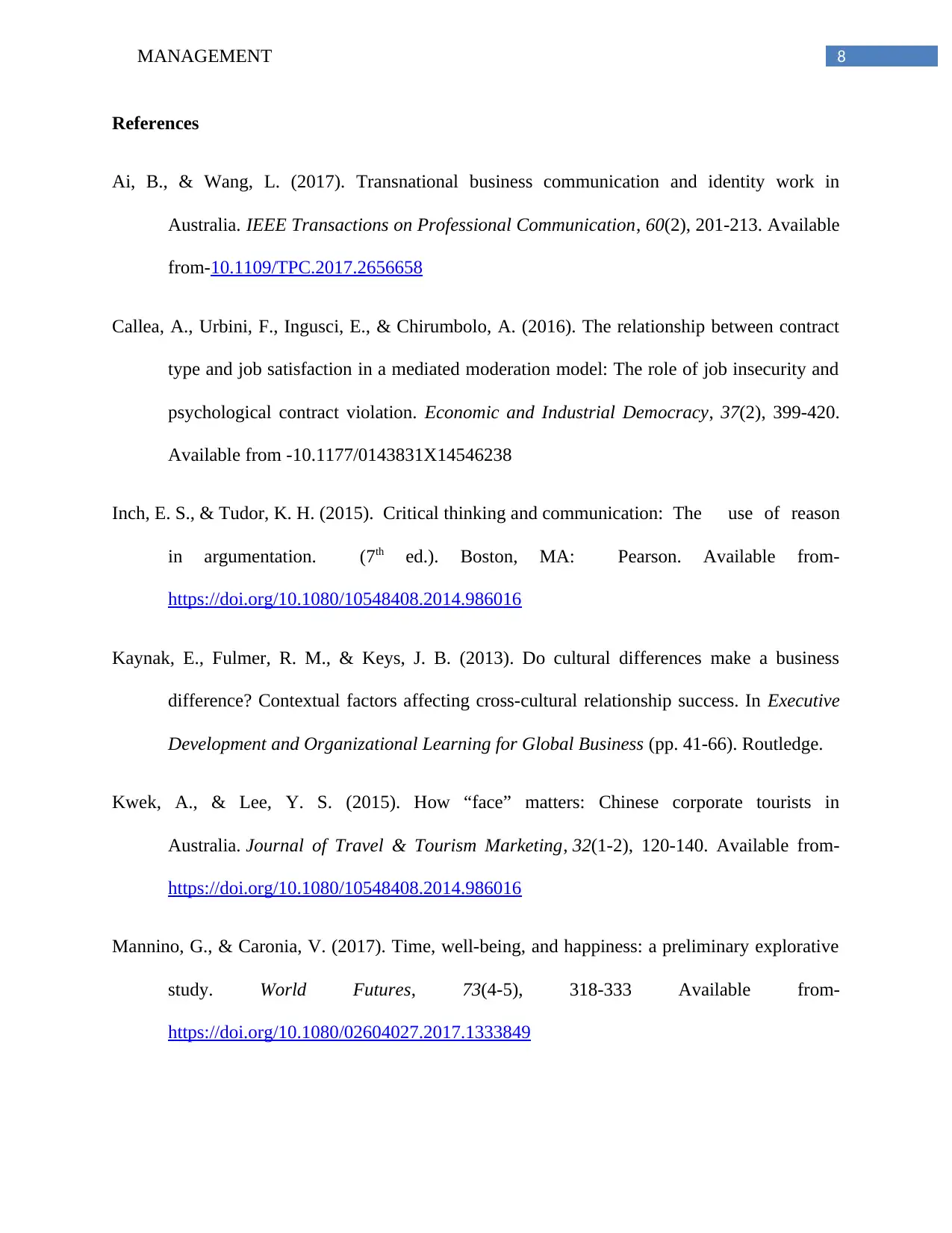
8MANAGEMENT
References
Ai, B., & Wang, L. (2017). Transnational business communication and identity work in
Australia. IEEE Transactions on Professional Communication, 60(2), 201-213. Available
from-10.1109/TPC.2017.2656658
Callea, A., Urbini, F., Ingusci, E., & Chirumbolo, A. (2016). The relationship between contract
type and job satisfaction in a mediated moderation model: The role of job insecurity and
psychological contract violation. Economic and Industrial Democracy, 37(2), 399-420.
Available from -10.1177/0143831X14546238
Inch, E. S., & Tudor, K. H. (2015). Critical thinking and communication: The use of reason
in argumentation. (7th ed.). Boston, MA: Pearson. Available from-
https://doi.org/10.1080/10548408.2014.986016
Kaynak, E., Fulmer, R. M., & Keys, J. B. (2013). Do cultural differences make a business
difference? Contextual factors affecting cross-cultural relationship success. In Executive
Development and Organizational Learning for Global Business (pp. 41-66). Routledge.
Kwek, A., & Lee, Y. S. (2015). How “face” matters: Chinese corporate tourists in
Australia. Journal of Travel & Tourism Marketing, 32(1-2), 120-140. Available from-
https://doi.org/10.1080/10548408.2014.986016
Mannino, G., & Caronia, V. (2017). Time, well-being, and happiness: a preliminary explorative
study. World Futures, 73(4-5), 318-333 Available from-
https://doi.org/10.1080/02604027.2017.1333849
References
Ai, B., & Wang, L. (2017). Transnational business communication and identity work in
Australia. IEEE Transactions on Professional Communication, 60(2), 201-213. Available
from-10.1109/TPC.2017.2656658
Callea, A., Urbini, F., Ingusci, E., & Chirumbolo, A. (2016). The relationship between contract
type and job satisfaction in a mediated moderation model: The role of job insecurity and
psychological contract violation. Economic and Industrial Democracy, 37(2), 399-420.
Available from -10.1177/0143831X14546238
Inch, E. S., & Tudor, K. H. (2015). Critical thinking and communication: The use of reason
in argumentation. (7th ed.). Boston, MA: Pearson. Available from-
https://doi.org/10.1080/10548408.2014.986016
Kaynak, E., Fulmer, R. M., & Keys, J. B. (2013). Do cultural differences make a business
difference? Contextual factors affecting cross-cultural relationship success. In Executive
Development and Organizational Learning for Global Business (pp. 41-66). Routledge.
Kwek, A., & Lee, Y. S. (2015). How “face” matters: Chinese corporate tourists in
Australia. Journal of Travel & Tourism Marketing, 32(1-2), 120-140. Available from-
https://doi.org/10.1080/10548408.2014.986016
Mannino, G., & Caronia, V. (2017). Time, well-being, and happiness: a preliminary explorative
study. World Futures, 73(4-5), 318-333 Available from-
https://doi.org/10.1080/02604027.2017.1333849
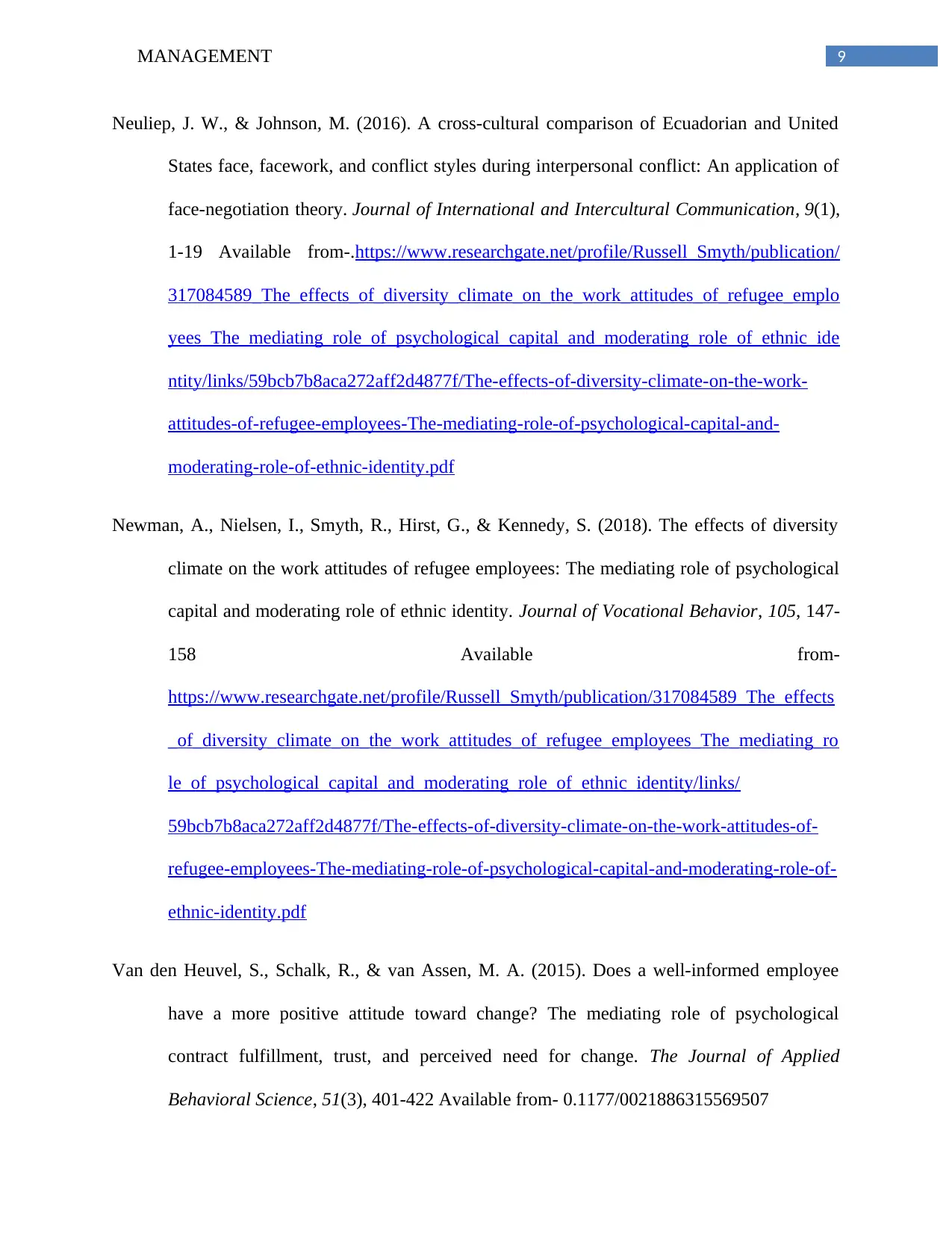
9MANAGEMENT
Neuliep, J. W., & Johnson, M. (2016). A cross-cultural comparison of Ecuadorian and United
States face, facework, and conflict styles during interpersonal conflict: An application of
face-negotiation theory. Journal of International and Intercultural Communication, 9(1),
1-19 Available from-.https://www.researchgate.net/profile/Russell_Smyth/publication/
317084589_The_effects_of_diversity_climate_on_the_work_attitudes_of_refugee_emplo
yees_The_mediating_role_of_psychological_capital_and_moderating_role_of_ethnic_ide
ntity/links/59bcb7b8aca272aff2d4877f/The-effects-of-diversity-climate-on-the-work-
attitudes-of-refugee-employees-The-mediating-role-of-psychological-capital-and-
moderating-role-of-ethnic-identity.pdf
Newman, A., Nielsen, I., Smyth, R., Hirst, G., & Kennedy, S. (2018). The effects of diversity
climate on the work attitudes of refugee employees: The mediating role of psychological
capital and moderating role of ethnic identity. Journal of Vocational Behavior, 105, 147-
158 Available from-
https://www.researchgate.net/profile/Russell_Smyth/publication/317084589_The_effects
_of_diversity_climate_on_the_work_attitudes_of_refugee_employees_The_mediating_ro
le_of_psychological_capital_and_moderating_role_of_ethnic_identity/links/
59bcb7b8aca272aff2d4877f/The-effects-of-diversity-climate-on-the-work-attitudes-of-
refugee-employees-The-mediating-role-of-psychological-capital-and-moderating-role-of-
ethnic-identity.pdf
Van den Heuvel, S., Schalk, R., & van Assen, M. A. (2015). Does a well-informed employee
have a more positive attitude toward change? The mediating role of psychological
contract fulfillment, trust, and perceived need for change. The Journal of Applied
Behavioral Science, 51(3), 401-422 Available from- 0.1177/0021886315569507
Neuliep, J. W., & Johnson, M. (2016). A cross-cultural comparison of Ecuadorian and United
States face, facework, and conflict styles during interpersonal conflict: An application of
face-negotiation theory. Journal of International and Intercultural Communication, 9(1),
1-19 Available from-.https://www.researchgate.net/profile/Russell_Smyth/publication/
317084589_The_effects_of_diversity_climate_on_the_work_attitudes_of_refugee_emplo
yees_The_mediating_role_of_psychological_capital_and_moderating_role_of_ethnic_ide
ntity/links/59bcb7b8aca272aff2d4877f/The-effects-of-diversity-climate-on-the-work-
attitudes-of-refugee-employees-The-mediating-role-of-psychological-capital-and-
moderating-role-of-ethnic-identity.pdf
Newman, A., Nielsen, I., Smyth, R., Hirst, G., & Kennedy, S. (2018). The effects of diversity
climate on the work attitudes of refugee employees: The mediating role of psychological
capital and moderating role of ethnic identity. Journal of Vocational Behavior, 105, 147-
158 Available from-
https://www.researchgate.net/profile/Russell_Smyth/publication/317084589_The_effects
_of_diversity_climate_on_the_work_attitudes_of_refugee_employees_The_mediating_ro
le_of_psychological_capital_and_moderating_role_of_ethnic_identity/links/
59bcb7b8aca272aff2d4877f/The-effects-of-diversity-climate-on-the-work-attitudes-of-
refugee-employees-The-mediating-role-of-psychological-capital-and-moderating-role-of-
ethnic-identity.pdf
Van den Heuvel, S., Schalk, R., & van Assen, M. A. (2015). Does a well-informed employee
have a more positive attitude toward change? The mediating role of psychological
contract fulfillment, trust, and perceived need for change. The Journal of Applied
Behavioral Science, 51(3), 401-422 Available from- 0.1177/0021886315569507
⊘ This is a preview!⊘
Do you want full access?
Subscribe today to unlock all pages.

Trusted by 1+ million students worldwide

10MANAGEMENT
Wei Tian, A., Cordery, J., & Gamble, J. (2016). Returning the favor: positive employee
responses to supervisor and peer support for training transfer. International Journal of
Training and Development, 20(1), 1-16 Available from-
https://onlinelibrary.wiley.com/doi/abs/10.1111/ijtd.12066
Wei Tian, A., Cordery, J., & Gamble, J. (2016). Returning the favor: positive employee
responses to supervisor and peer support for training transfer. International Journal of
Training and Development, 20(1), 1-16 Available from-
https://onlinelibrary.wiley.com/doi/abs/10.1111/ijtd.12066
1 out of 10
Related Documents
Your All-in-One AI-Powered Toolkit for Academic Success.
+13062052269
info@desklib.com
Available 24*7 on WhatsApp / Email
![[object Object]](/_next/static/media/star-bottom.7253800d.svg)
Unlock your academic potential
Copyright © 2020–2025 A2Z Services. All Rights Reserved. Developed and managed by ZUCOL.





